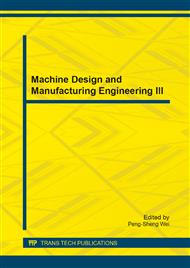p.362
p.368
p.376
p.382
p.386
p.393
p.397
p.405
p.409
Inherent Characteristic Similarity Analysis on Short Thin-Walled Cylindrical Shell
Abstract:
A method for predicting the vibration characteristics of the short thin-walled cylindrical shell was presented by dynamic similarity analysis. Firstly, the similarity conditions between the prototype system and its complete-similitude scale model were derived from their equations of motion. Then, the scaling factors, such as length, radius, thickness, force, and excitation frequency, spring constant and dynamic responses of the cylindrical shell were determined based on the last similarity conditions and the dimensional analysis theory. Free and forced vibration analyses of the elastically supported prototype cylindrical shell and those of its complete-similitude scale model were performed to validate the derived scaling laws, and satisfactory results were obtained.
Info:
Periodical:
Pages:
386-392
Citation:
Online since:
July 2014
Authors:
Price:
Сopyright:
© 2014 Trans Tech Publications Ltd. All Rights Reserved
Share:
Citation:


